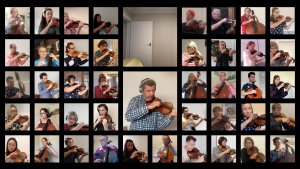Composers strike a chord with WASO musicians
05.05.2020
Liz Chee, Associate Principal Oboe
My favourite composer is always changing depending on what I’m currently listening to, have played recently, or have seen in concert. At the moment I’m really enjoying Sibelius, Poulenc, Sondheim and Stravinsky.
One the works I’ve listened to the most in the last few years is Poulenc Concerto for 2 Pianos, FP 61 in D minor, I first got to know this piece about five years ago when I played the 2nd oboe/cor anglais part with the Malaysia Philharmonic. I listened to it again last week and really enjoy Poulenc’s harmonic language and use of colour from the combinations of instruments and chords.
Recently I enjoyed the Poulenc Les Biches that we played in our last concert in March (Dances with Daphnis). It really reminded me of Stravinsky’s Pulcinella which is another favourite piece of mine. Pulcinella is riddled with good oboe solos and tunes, as is Les Biches. A lot of the Pulcinella oboe solos are core excerpts for oboe orchestral auditions (so luckily I enjoy them).
I came to love Sibelius when playing through a lot of his symphonies with the New Zealand Symphony Orchestra about 12 years ago. They had a Finnish Chief Conductor and Concertmaster at the time. I particularly love the Violin Concerto and Symphony No. 3, his works are always so icy and expansive sounding.
Even though I get paid out for it, I love my musicals. I especially enjoy the writing of Steven Sondheim with his musicals Merrily We Roll Along, Sunday in the Park with George, Sweeney Todd and Into the Woods. I used to listen to these over and over as a child so I know most of the words.
Alex Timcke, Principal Timpani
One of my favourite pieces of all time is The Firebird Suite, by Stravinsky. It was originally a full blown ballet, with choreography by the famous Russian choreographer Serge Diaghalev, but the suite is now heard far more often than the whole ballet. I originally heard this piece in my first year at university and was immediately taken with the sounds and colours that Stravinsky used. It was unlike anything I'd heard before, and I literally listened to it hundreds of times trying to work out what he was doing, and how he achieved particular sounds. I studied the score and familiarised myself with his style and sound, but all the hours of work didn’t ever take away from that initial fascination. I found it absolutely absorbing.
I was finally able to play it with a full orchestra a couple of years later, when I was playing with the Australian Youth Orchestra. It was an amazing experience for me, particularly since AYO was doing a European tour at the time, but also because the piece had become a close friend by this time. I knew it intimately, and found it quite emotional sitting in the middle of such an excellent orchestra producing all those amazing Stravinsky sounds. There are two parts that I really love. The gorgeous horn solo towards the end, which sits gently on a sound of shimmering strings. And then the finale, which has quite a prominent timpani part. For those that know a bit about music, this section is in the unusual time signature of 7/4, but it somehow manages to be full of long phrases that make the brass and timpani sound awesome.
If you get a chance to hear this piece live in a concert hall with a full symphony orchestra, don’t miss it!
